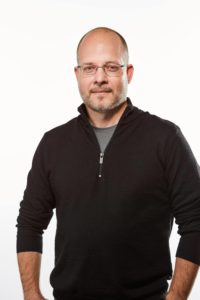
Jeremy Shubrook – Courtesy of Eric Lubrick. Used by permission.
Weeks ago, I saw a performance of “Halftime with Don” at Phoenix Theatre, after which I attended the show’s producer’s party. While there, I met a new counterpart, Jeremy Shubrook. After just a few minutes of chatting, I quickly realized we shared common interests once I discovered Shubrook has over 15 years of experience in arts organizations in roles that combine artistic programming and production.
Currently, Shurbrook is director of festivals, performance and public programs at Newfields: A Place for Nature and the Arts, where he oversees all public programming on the 152-acre campus that is also home to the Indianapolis Museum of Art. Before joining Newfields, Shubrook was the director of production at the Adrienne Arsht Center for the Performing Arts of Miami-Dade County. His experience also includes management of the Performing Arts, Music and Film series at the Cleveland Museum of Art. He holds a B.A. from the University of Texas at Austin.
Shubrook and I met at Newfields recently where we sat in The Café inside the IMA for the following interview drawn from an edited transcript.
What was the outcome of your holiday program “Winterlights.”
There are surveys that are being evaluated right now. We have an evaluation team here on site that does that, that processes all that information. I don’t have all those answers, but I can tell you we nearly doubled our expected attendance for the run of “Winterlights.” So, we originally intended to have about 35,000 folks on campus for “Winterlights,” but it was closer to 70,000.
So would you say it was wildly successful?
Definitely, especially for a first-year program.
What was its impetus?
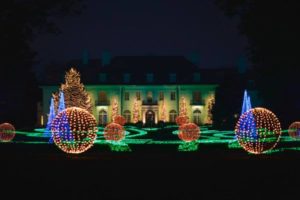
“Winterlights” – Courtesy of Eric Lubrick. Used by permission.
This is all prior to my arrival here. It had been under consideration for about three years. Charles Venable (Newfields president & CEO) had this idea. He had seen what other garden centers were doing, thinking of what a campus of this type should do during the off season for the gardens and we saw this model very successfully being operated at places like Longwood Gardens, Morton Arboretum, and Cheekwood Botanical Gardens. Members of the staff started doing research around the U.S. and overseas as well, looking at the success of some of these holiday programs.
Again, it’s one way of thinking about why we changed our name to Newfields. How do we activate this entire campus year-round? That’s part of it, for sure, but also, we are looking at the emotional ties to different seasons for our population. What is it that drives the average Hoosier during the winter months? What are they looking to do with their time? We realized the traditions during the holiday seasons are very important to folks here, so could we create a new tradition for Indianapolis? Experience is a big catchphrase that is being used all over by arts and culture institutions. We tied back to things we are already doing. We used to do Christmas at Lilly House. We wanted that to be a part of “Winterlights,” so we opened up Lilly House this year. It didn’t have the same name, but we did a lot of the same things we have done in the past.
How did the IMA find you?
At one time, I was at the Cleveland Museum of Art, also working with performance and film. Charles Venable was also there for many years. So, my last three years, I overlapped with Charles. He was our deputy director of collections and programs. I was working in his division. We kept in touch over the years and when Scott Stulen left us to become director of the Philbrook Museum, I came up as a consultant. Based on a conversation Charles and I had in Miami, he wanted me to come and see the campus and look at what the possibilities might be for changing the way we look at public programs. Specifically, how do we activate these assets that we have built into the campus, like The Toby, Amphitheater, Art and Nature Park, and gardens, in ways we might not have done before and also on a scale we might not have done before? So, I came in at that capacity in August of 2016. So, we walked and talked and had a really great conversation and crafted the future of that position. Then, he asked me if I wanted to apply for it and by October of that year I was applying for the position and I started in January of 2017.
What were your mandates?
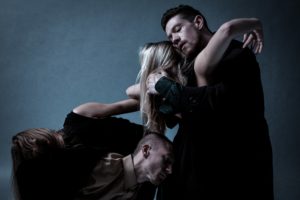
Kate Wallich & The YC: “Industrial Ballet – March 2 & 3 Courtesy of Carl J Asquini. Used by permission.
In designing this new vision for public programs, the thought is, how do we do things on a different scale than we might have done before? How does performance fit into this? This is an experiment I am going through right now. Should performance be a large part of our offerings here? We have the facilities to do it. What does that look like? How do we partner with other organizations to help create these audiences? What part of that audience that we could potentially build is already coming here? Is there an audience that we could build for performance or other public programs, festivals of different types that might then create a new museum member, a new garden member?
Are people who are passionate about the visual arts equally so about the performing arts?
Some of them are, but not all of them, I would say. This is a very dynamic city, with a lot of rich offerings in the performing arts. I would not doubt that. I have been out to see everything. I have been to about 85 performances in the year that I have lived here, so I am researching what’s happening here in the market and looking for the holes. So, what is it that we, as this campus, can uniquely offer by nature of our facilities? What isn’t being offered successfully across the market that we can then be the provider of? It is almost a complementary approach, rather than a competitive approach. We are working with Young Actors Theatre and Indianapolis Ballet, so that means we now have two resident companies here. We have activated the Toby Theatre in a very strategic way. These are organizations that are their own producers. They are creating their own product. We are not responsible for creating that product, but we, as partners, are offsetting their operational costs, so we, together, are building a new audience. But, the financial risk is not so much on this organization. By nature of this partnership, we create a relatively affordable, professional environment for these companies to operate in and, again, grow our own audience in and they are still the ones creating the product. It’s win-win having two resident companies.
Does that mean that Young Actors Theatre and Indianapolis Ballet are attracting wider audiences?
As we are. I do believe there is crossover between those two companies and our audience that exists for the galleries and all of that, but there may be audiences that might not have come here before.
Do you think patrons of the two companies will come back to IMA after seeing shows at The Toby?
I would hope so. A perfect example was before we became partners with Indianapolis Ballet, when they did the “Coppélia” program last year. I was walking down the hallway on opening night of that performance and I heard people saying “I didn’t even know this theatre was here!” I imagine that now that they have been in this building, they could have returned to see “Winterlights.” They could have come to the “City as Canvas” exhibition. One of the first performances I programmed when I got here was the Doug E. Fresh hip-hop show and that was opening night of “City as Canvas.” We specifically tied that performance thematically to the exhibition. So, you have an exhibition of 1970s and 1980s New York graffiti and you have a hip-hop artist opening the evening who was recording music during one of those decades. I know for a fact, there were people who came to that performance who had made very few visits here in the past or had never been here before.
You are always interested in expanding your demographics, right?
Absolutely. One of the ways we approach that is we have a series of studies we did internally on ourselves that were funded by a Lilly Endowment grant and one of those studies was a marketing segmentation study. We discovered which part of our market audience we weren’t hitting, so we identified our core audience —the museum-goers, the garden-goers—and then we realized there was this other audience we call the “movable middle.” We realized they would probably come here if we had something to offer them, if we invited them the right way here, and that is one of the things I am challenged with is finding experiences that will speak to that audience.
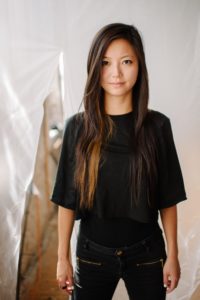
Vicky Chow – Feb. 6 Courtesy of Kaitlan Jane Photography. Used by permission.
Maybe it’s been here all along. They just didn’t know, so is it that we do a public program in a gallery, like the Vicky Chow piano performance that is coming up? We’re going to do that. The performance is Feb. 6 in our Pulliam Family Great Hall, which is the entry hall to the galleries. We are doing a musical performance of all contemporary living performers. It’s an interesting, warm, acoustic space. Music has been done there before, but nothing of this format, where it is ticketed, and assigned-seating chamber music. We are going to create a small thrust stage. It’s going to be 134 seats and we are going to use the third floor as box seating, so we are going to have VIP tickets in the box-seating area for that show. It’s all contemporary music—all living composers. Think the American Pianists Association or the International Violin Competition. They are amazing programs that are doing chamber music, but are they doing a lot of contemporary chamber music? I don’t know. I don’t know if they are doing chamber music as much as they are doing more traditional, classical period music, so for me, that was one of the places to find a gap.
That makes great sense.
And complementing. I think it is about building the audience’s appetite. I think what we are all doing here can be a lot…we all move together…so all of these things we are presenting…we’re building a better audience. We are building an appetite and that is why you’ll see me at Phoenix Theatre. That is why you’ll see me at “Cabaret Poe,” White Rabbit Cabaret for “Let’s Make a Date” or something similar. There is something that is very unique about this market and something I have not seen elsewhere. There is sort of an interesting kitsch factor here too. The White Rabbit does exceptionally well. They hit that market with surreal programming that really tickles the fancy of folks. I like that and I think that because it is so surreal, you don’t have to ask permission to go to it because it is so far outside the norm.
Do you think there is a good avant-garde scene here?
I have been to IndyFringe. I have been to Indy Reads. There are some really interesting things going on. I haven’t been to a NoExit Performance show yet. I have been to two Catalyst Repertory performances, one of which was at Grove Haus, the other at Theatre on the Square.
Let’s talk about film. What is your background in cinema?
I have been involved in a film program for the better part of my career in way one or another. I have not been involved in producing it, but I have presented it. I have been the curator of film programs in the past. We do have a film programmer on our team. Our assistant director of public programs is our film programmer, so for the most part, I stay out of her way and let her have her vision for that program. Every once in a while, I will put something in play that I might want to see, so, for example, with the upcoming “Winter Nights” film program, it’s completely built around soundtracks and scores. For me, one of the films I wanted to see in that series was “Elevator to the Gallows.” For one, because Jeanne Moreau passed away in the last year and secondly, the Miles Davis score for that is quite amazing. It really is an exceptional film, but you may like the other stuff our director, Lindsay Hammon, has chosen. It’s a diverse program. We had a year off from that film program, but we wanted to come back with a bang and we condensed it into double features.
Where are they shown?
In The Toby and some of those are on 35 mm because we have that capability. You’ll see the films that are listed with asterisks are actually shown on 35 mm. One of the things that comes with that is we have Indy Film Fest here, 100 percent. We have the LGBT Film Festival here, 100 percent. We do the Indiana Black Expo Film Festival, which is a one-day festival. Heartland has done a series of their film screenings here in the past. We are about to expand that relationship.
What about the Summer Nights Film Series?
It is still going strong. We are expanding it. This summer, we’ll have 19 films. That is up by about 20 percent from last year. One of the ways we are looking to expand capacity for the series since it sells out constantly is to hold a few of our screenings in the Art and Nature Park in addition to the Amphitheater, so we can have a larger audience.
What are your thoughts about Indy, in general?
I like the DIY spirit here. What I see is a collaborative group effort, so you have to grow a consensus here for things to get done and I have seen that done quite well, as far as moving things forward, whether it’s the cultural scene or the restaurant scene. A lot of public will. There is definitely something very strong here that I didn’t experience when I was in Miami.
Do you think there is much experimental work being done in our city?
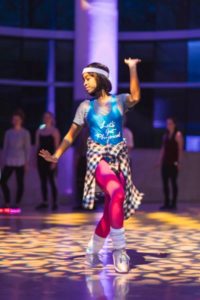
Instructor Lauren Curry, Seasonal Affective Disco – Courtesy of Samantha McCain. Used by permission.
We’re doing disco at dawn or what we’re calling the “Seasonal Affective Disco” program. It’s an experiment; I don’t know if it is really going to take. We have only done two iterations of it. We have two more to go. It’s teasing out something I haven’t seen in this market, but I have seen it work in other markets and I am thinking, “Why not try it?”
Tell me about it.
“Seasonal Affective Disco” is my way of fighting the winter blues. There are plenty of people who go to morning exercise classes. I knew that was out there, but how can we change the thought processes of people not wanting to get up and go out, especially in the winter months? So, what we offer is a combination exercise class and dance party. We promote healthy living, so we have a juice bar. We also have a coffee bar. We have movement instructors who help get the class warmed up and get your inhibitions down. We also have a psychologist on site who is a resource for those who want to know about Seasonal Affective Disorder and is available to talk to people more about this phenomenon. I hope other than being something that is fun, that it helps people get through this time of year. Some people get really affected and depressed by the disorder. I think this is just one way of celebrating during a time you might feel down. We chose to do it in the Efroymson Pavilion because the wall faces east. We start with club lighting pre-dawn and ultimately the sun comes up at the end of the experience. This has been presented in other places under other names. I chose to call it this because it spoke specifically to here, but there is a movement around the world, actually, where they are doing this called “Daybreaker” and I wanted to take my own stab.
What are your short-term goals?
My short-term goals are definitively expanding our audiences beyond the core so we can program for audiences that may not have thought this place was for them; definitely activating our performance spaces because we have those unique assets as part of our campus, the Amphitheater, The Toby, the Art and Nature Park, the Lilly House. I want to make sure we are really using those assets that we have here every day.
Long-term?
Personally, although we have a strong film audience here, I would like for us to be a premiere film presenter, even if that means partnering with Heartland or Indy Film Fest as the premiere film-presenting venue in the city. I have to remember that a lot of the programming I am doing is promoting exhibitions. There are things we do with academic engagement. There are things we do with family programming that speak directly back to the artwork.
What is your message to the public about why they should come to the IMA?
The IMA is still here and guess what? You may come here and see something you expected to, but you may find something new here too and that is part of what we may bring. What happens when you come to a piano recital in the galleries? Are you tempted to explore further as a patron of the visual arts here before or vice versa? What if you’ve been through that Pulliam Great Hall a million times, but you never thought of coming to a concert here? That could be a very interesting transitional point for somebody that was or was not one of our regular audience members.
For information regarding exhibitions and programs at Newfields, visit discovernewfields.org.

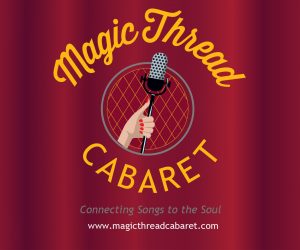



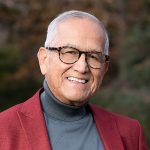
One Comment
Great piece, Tom.